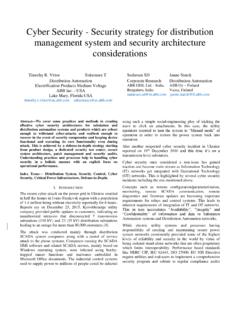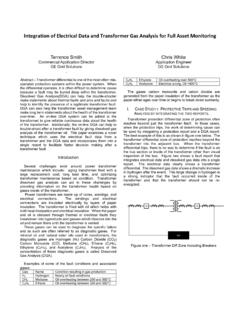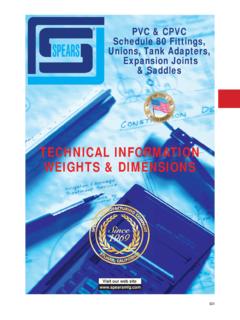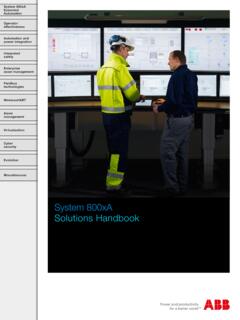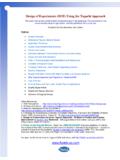Transcription of Circuit Breaker Ratings – A Primer for Protection Engineers
1 Circuit Breaker Ratings A Primer for Protection Engineers Bogdan Kasztenny, Schweitzer engineering Laboratories, Inc. Joe Rostron, Southern States, LLCA bstract This paper explains the asymmetrical short- Circuit interrupting current rating for high-voltage Circuit breakers. The paper teaches how the decaying dc component in the asymmetrical fault current affects the Breaker , and it explains how the X/R ratio and the relay operating time affect the asymmetrical current Breaker rating.
2 The paper briefly introduces, and illustrates with field cases, several ultra-high-speed Protection principles that can operate in just a few milliseconds. The paper then explains how to derate a Breaker for the relay operating time that is shorter than the standard reference value of cycle. The paper calculates the rating loss due to fast tripping and suggests that applying customary margins when selecting breakers may be sufficient to mitigate the effect of ultra-high-speed relays without the need to replace breakers.
3 I. INTRODUCTION The four major components of any Protection system are instrument transformers, protective relays, Circuit breakers (CBs), and control power circuits. Current and voltage instrument transformers supply input signals to protective relays. Protective relays provide a wide range of Protection functions, including but not limited to short- Circuit Protection . When tripped by protective relays, breakers interrupt the fault current to isolate the affected zone from the rest of the power system.
4 In high-voltage applications, the differential and directional comparison schemes, as well as the underreaching distance and overcurrent elements, provide instantaneous Protection against short circuits. With security as the paramount performance factor, the faster and more dependable the Protection system, the better. With all other factors equal, a faster relay is always preferred over a slower one. Instrument transformers create well-recognized challenges for protective relays.
5 Designed for the fundamental frequency component, instrument transformers may introduce transient errors. Capacitively coupled voltage transformers (CCVTs) generate slowly-decaying components in their output voltages that challenge both speed and security of distance Protection elements, especially in weak systems. Current transformers (CTs) may saturate due to high currents or long-lasting decaying direct current component (dc) offset in the primary current.
6 Protective relay designers and practitioners have a good grasp of these instrument transformer transients, limitations, and failure modes. For example, we know how to derate a CT to account for the actual CT burden, dc offset (X/R ratio), residual flux, or low-frequency operation. In contrast to their focus on instrument transformers, relay practitioners pay less attention to the other component of the Protection system the Circuit Breaker . This paper aims at closing this gap and introducing Protection practitioners to the basics of Breaker rating.
7 Manufacturers specify the fault current interrupting capacity of their breakers for a set of reference conditions including, among other factors, voltage, frequency, decaying dc offset in the fault current, relay operating time, temperature, and altitude. This paper teaches the basics of how breakers are specified and explains rules for derating breakers for operating conditions that differ from the standard reference values. Special attention is given to the decaying dc offset in the short- Circuit current and the relay operating time.
8 As per current standards, the fault current interrupting rating of a Breaker accounts for the asymmetrical fault current interruption; , it accounts for the decaying dc offset in the fault current. The decaying dc component is time varying. It subsides and makes the current interruption an easier task with the passing of time. The key standards for CBs, ANSI/IEEE [1] and the IEC counterpart IEC 62271-100 [2], use the X/R ratio of 17 (60 Hz system) and the relay operating time to establish a reference condition for the decaying dc component.
9 With these assumptions, the standards ask Breaker manufacturers to specify the nameplate interrupting rating for an asymmetrical current. As a result, Breaker applications are simplified because the users can directly apply the nameplate rating without extra calculations if their relays are not faster than cycle and their system X/R ratio is at or below 17. How does one derate a Breaker for relay operating times that are faster than cycle or a system X/R ratio higher than 17?
10 Breaker practitioners routinely derate breakers for systems with higher X/R ratios. Historically, however, the relay operating time was rarely questioned, and today, users normally do not derate breakers to account for specific relay operating times. Today, new types of relays have emerged that operate faster than cycle [3]. Application of these relays calls for evaluating Breaker Ratings . This paper is a Primer for Protection Engineers , and it teaches how the Breaker rating depends on the X/R ratio and the relay operating time (Sections II and III).

